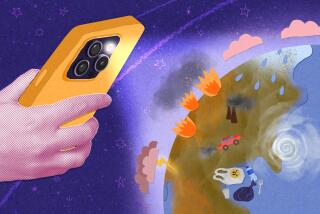The dystopian future is already underway in Maja Lundeâs novel âThe History of Beesâ
âOur children and grandchildrenâ is a phrase often wheeled out in conversations about climate change. For politicians searching for heartstrings to tug, this is a logical rhetorical strategy, appealing to votersâ instincts to protect their kin. But it backfires in projecting the changing world into the future, as if we didnât already live on a planet where rising sea levels and sinking land have forced Americans from their homes, where drought caused by human activity is contributing to mass migration and war.
Writers have played their part in this collective delusion about the present day. Recent speculative works set in a near future several imaginative leaps away include the still-functioning, half-submerged Manhattan in Kim Stanley Robinsonâs âNew York 2140â and a post-apocalyptic, desiccated L.A. in Claire Vaye Watkinsâ âGold Fame Citrus.â
Norwegian author Maja Lundeâs âThe History of Beesâ â fluidly translated by Diane Oatley â breaks the mold by tracing the origins and effects of human meddling in nature through three story lines, spanning 250 years: a down-on-his-luck apiarist in rural England in 1851, an Ohio beekeeper in 2007, and a bereft mother in China in 2098. This structure allows for some standard speculation: In Lundeâs dystopian 2098, bee die-out and subsequent food shortages have sent the global population plummeting, leaving Beijing a near ghost town, while in rural areas the already real practice of using human labor for pollination has boomed. âI was assigned to Field 748 today,â says our Chinese protagonist Tao. âOut of how many? I didnât know. My group was one of hundreds.â
In Lundeâs dystopian 2098, bee die-out and subsequent food shortages have sent the global population plummeting.
But the tripartite structure also allows for what the novelist Ashley Shelby recently described as First Impact Fiction: fiction set in more or less the present day, which depicts âour shared world as the impacts of runaway climate change begin to make themselves known.â In passages of realist domestic drama, George, our Ohio beekeeper, faces the very real trauma of Colony Collapse Disorder (CCD) â the mass disappearance of his bees â while trying to persuade his academic son to join him in the family business. In this way, the novel illustrates that climate change isnât a problem of tomorrow but of today. And by stretching the storyâs tentacles back to the days of the Industrial Revolution, Lunde also demonstrates that the unsuccessful attempt to override nature isnât merely underway, itâs two centuries old. Our children and grandchildren, goes the trope â but also us, our parents, grandparents and great-grandparents.
âThe History of Beesâ was a bestseller in Norway and Germany; it won the 2015 Norwegian booksellersâ award, and rights have been sold in more than 15 countries. Itâs a deftly managed if somewhat predictable story â but perhaps itâs precisely the novelâs pedestrian qualities that have made it such a winner: âThe History of Beesâ brings climate change into the realm of book-club fiction. It does so partly through a heavy emphasis on family: In addition to presenting the past, present and future of ecological meddling, the tripartite structure allows Lunde to explore the related theme of parenthood and the progression of generations.
The novel illustrates that climate change isnât a problem of tomorrow but of today.
Each narrative strand follows a parent struggling with the role. âThese were uncertain times,â Ohio beekeeper George thinks while planning a beekeeping future for his decidedly uninterested son. âI created security. I alone created security for this family. A future. But it didnât seem like anyone understood that.â
The novel connects the parent-child relationship with the cooperative social structure of bees â eusociality. âA single personâs life, a single personâs flesh, blood, body fluids, nerve signals, thoughts, fears and dreams meant nothing,â thinks Tao. âMy dreams for [my son] didnât mean anything either, if I failed to put them into a context and see that the same dreams had to apply to all of us.â
Here, the novelâs message grows muddy. Are humans eusocial, or at least capable of behaving as such? Crucially, we differ from classically eusocial species in that we can each reproduce; reproductive labor isnât assigned to, say, a queen bee. We have families and competing tribes instead of a hive mind, and invariably itâs the gene-deep pull of our tribal bonds that drives us to destruction.
Lundeâs exploration of the tension between human instinct and the need for selflessness couldnât be more timely. Itâs just a shame that readers must settle for an earnest but contra-21st century and possibly contra-human entreaty about the meaninglessness of a single human life, rather than a more satisfactory reckoning of our shared future.
Robins is a writer and translator who lives in Los Angeles.
âThe History of Beesâ
Maja Lunde, translated by Diane Oatley
Touchstone: 352 pp., $26
More to Read
Sign up for our Book Club newsletter
Get the latest news, events and more from the Los Angeles Times Book Club, and help us get L.A. reading and talking.
You may occasionally receive promotional content from the Los Angeles Times.








